My Attempt at Explaining the Religion of Judaism
It seems there are countless questions from inquiring minds…a beloved friend asking me “What does it mean to be Jewish?” or a boss asking me “What is the atmosphere like during your High Holiday celebrations?” or even a fellow grocery shopper asking me “What does keeping Kosher mean?” These are all great questions, and I’m excited to attempt to explain my most cherished experiences and celebrations to readers who may not be familiar with Judaism. However, as I sit here and try to explain these seemingly simple questions, I am having a hard time coming up with easy, straightforward answers.
You see, Judaism can be considered a lot of things to the 14.2 million Jews in the world1. Yes, at its core, it is a monotheistic religion with a set of beliefs and rules based off of the Torah—the foundational narrative of the Jewish people and their covenant with God2. But, as in many religions, there are different levels of observances. Nonetheless, all Jews use the Torah as their foundation.
There are three factions of Judaism:
Orthodox, a branch of Judaism that has the strictest adherence to traditional Jewish practices and beliefs, strictly follow Jewish Commandments and Laws of the Torah. For example, they observe all dietary laws i.e. no pork, shellfish, no mixing dairy and meat at the same meal, even kitchen utensils must be Kosher. Also, to obey the Sabbath, meaning from Friday sundown until Saturday sundown when three stars appear, no driving, no turning on lights or doing any work whatsoever, after all it is a day of rest!
Then, there are conservative or traditional Jews. They are less strict in their observance but are still somewhat traditional in their worship.
Reform Judaism is the most “liberal” or “progressive” Judaism, where strict adherence to the laws of the Torah are not as important as a personal connection to Jewish tradition, such as being a part of a Jewish Youth Group, lighting candles for Shabbat (a day of rest and celebration that begins on Friday at sunset and ends on the following evening after nightfall), attending Synagogue during holidays or cooking traditional
Jewish food with your grandmother or as we like to call her, bubbe.
And to make it even more complicated, there are many different organizations, beliefs, practices, cultural backgrounds and identifying factors within every level of observance. So, while I stated just the three main types of Judaism, there are many more branches. If you’d like to get a better understanding than we have time for here, I recommend this book Basic Judaism. Let’s just say, all people who identify as Jewish no matter where on the “spectrum” are all part of a family or connectedness stemming from common practices and beliefs.
All That Being Said, I am NO Expert
That was all spoken through a bit of my experience and a bit of research, but I do want to mention that I am by no means an expert on Judaism, religion, Jewish Law, the Torah, any of the above that I mentioned. I am no Rabbi, no preacher, no teacher, I do not have a degree in religion. What I am is a 23 year old who considers herself Jewish, so you can take or leave my level of “expertise” as you wish.
One thing I do want to highlight, and you will notice it throughout my post, is FOOD. Food and family are paramount to the Jewish religion. I’d say food and family go pretty hand in hand. If you identify as Jewish for any of these reasons:
One (or both) of your parents are of Jewish descent
You are culturally Jewish – Perhaps went to Sunday School or Hebrew School or attended a Jewish sleep away camp
Maybe just your grandmother practices Judaism
Perhaps you go to Synagogue every Friday to observe Shabbat
You do not use your cell phone or drive a car on Shabbat
Every one of you has at least eaten one of the following: kugel, challah, matzah, knishes, bourekas, latkes, charoset, kibbe, rugelach and mandelbrot. Enjoying a festive meal with close family and friends is something, I’d say, every Jewish person, no matter what branch has in common.
So, as I explain my experiences with the Jewish High Holidays, you may notice a reoccurring theme: Food and Family, which are truly important to me.
The Jewish High Holidays
The Jewish High Holidays consist of Rosh Hashanah and Yom Kippur. While those two holidays only take up three days (two for Rosh Hashanah and one for Yom Kippur) the ten days in between the two holidays are also very meaningful, as this is a time for repentance and atonement – – but more on that later.
It may seem confusing as to when Jewish holidays occur, because to someone observing the solar calendar (most Americans) the holidays do not fall on the same day every year. However, Judaism follows the lunar calendar, so really, the holidays always take place on the same day! I know, it’s even hard for me to keep up with! And another thing to note is that Jewish holidays start the evening before the day on the solar calendar. So while Rosh Hashanah fell on September 14th and 15th on the solar calendar this past year, it really began on the night of the 13th, and continued into the day of the 14th and 15th until sundown. Here is a scenario I thought was funny:
Attorney 1: Monday is Rosh Hashanah, but I’m available for trial on Tuesday
Attorney 2: I’m unavailable for trial on Monday and Tuesday because I will be observing Rosh Hashanah.
Attorney 3: I have to leave early during Sunday’s session for Rosh Hashanah and I’m back, available for trial, on Wednesday.
Judge: Is this holiday one day, two or three?
Attorney 1: One day.
Attorney 2: Two days.
Attorney 3: Three days.
– Inspired by a true story ³
Attorney 1 celebrates Rosh Hashanah just on the first full day of the holiday. Attorney 2 celebrates on the first and second day of the holiday.
Attorney 3 celebrates on the night before the first full day of the holiday, the first full day of the holiday, as well as the 2nd and last day of the holiday.
Remember, “days” start at sundown and end on sundown the following day. So, it really depends on your level of observance and specific family traditions when it comes to how long a Jewish holiday is, or is celebrated.
Here is a picture of a solar calendar and a lunar calendar (Jewish dates in grey and holidays in color) to help you better understand:

Rosh Hashanah – The Jewish New Year
Rosh Hashanah marks the start of the Jewish High Holidays and is on the first day of the Jewish month Tishrei. It is the Jewish New Year (literally means head of the year) and marks the beginning of a 10-day period of prayer, self-examination and repentance. This period, known as the Yamim Noraim (Days of Awe or High Holy Days), is widely observed by Jews throughout the world, many with prayer and reflection in a synagogue.⁵
To help you get a better idea, you can somewhat consider Rosh Hashanah like the American New Year celebrated in January. Like the American New Year, Rosh Hashanah is a festive and happy celebration with food, family
and friends. And also, it is a time to look back at the past year and make resolutions for the upcoming year. Although there are some similarities, there are differences, as well. Rosh Hashanah is a bit more solemn than the American version, and it is a wake-up call to begin mental preparations for the upcoming Day of Atonement, Yom Kippur. A proper greeting for this holiday is L’Shanah Tova or Happy New Year!
While I did not take any pictures of my family or myself in synagogue (that would be a huge no-no), I can show you some of our holiday rituals celebrated at home!
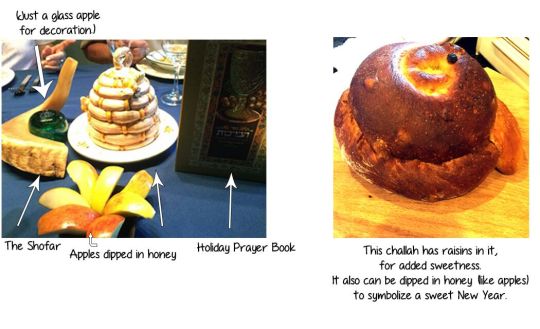
Starting on the left side of the left picture, for the Rosh Hashanah meal, you can see a Shofar, which is a ram’s horn. It is blown for a number of reasons (one is to announce the New Year), but also, to awaken our spirits for this time of repentance. The beehive represents honey, which we dip apples in to symbolize a sweet new year. The book on the right is the holiday prayer book, which we use to read blessings from before, during and after our meal.
The right picture is a round challah. You may be more familiar with this bread when it is baked into braids. The reason we eat a round challah on Rosh Hashanah is to symbolize the continuation of life, the cyclical passage of time and the revolving seasons.
Now onto some more traditional Jewish foods! Typically apples dipped in honey are served at the beginning of the meal to wish that the coming year will be sweet and good. In fact, many dishes at the special holiday meal are served with sweet ingredients for the same reason.
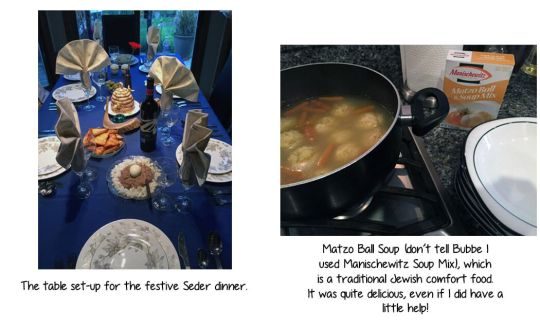
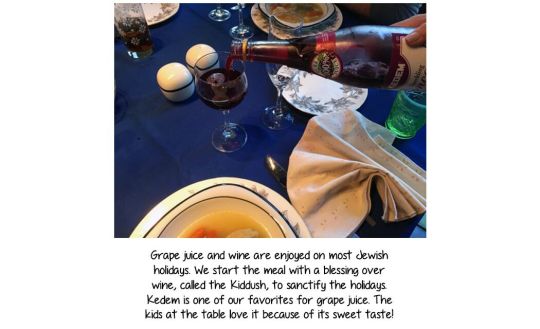

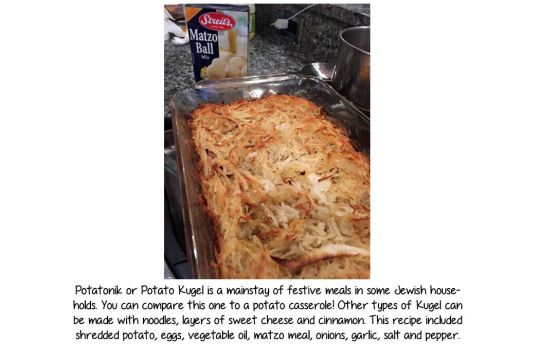
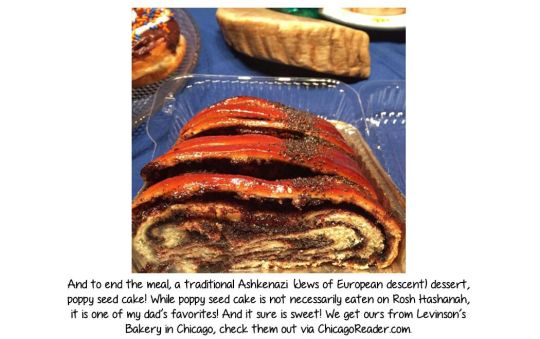
My family’s Rosh Hashanah festivities include attending synagogue, prayer and festive meals with each other and friends as you can see from the photos above. We rang in a sweet New Year together, and now we are ready for the ten days leading up to Yom Kippur (pronounced Key-poor).
Yom Kippur – A Day for Atonement and Repentance
Yom Kippur is the holiest day in the Jewish calendar and concludes the period known as the High Holidays.
The ten days in between Rosh Hashanah and Yom Kippur are spent focusing on repentance and atonement. According to Jewish law, while God passes judgment on Rosh Hashanah, the books of life and death remain open
during the ten-day period in between the two holidays, so that Jews have the opportunity to change which book they are in before it is sealed. ⁶
Yom Kippur is the final day to ask God for forgiveness for all of the wrongdoings over the past year and before the books of life and death are sealed. It is a time to make peace with ourselves and promise to be better in the New Year. The Holiday lasts one day from sundown to sundown.
Even Jewish people who do not regularly go to synagogue or are not very observant attend prayer services during this holiday (of course, not all). And, as part of this atonement, Jews who are physically able are required to fast for an entire day.
The evening before the holiday, a long and slow meal is enjoyed before sundown. After which, fasting, prayer, reflection and repentance are observed for the next 25 hours.
At the end of Yom Kippur, Jews who have atoned consider themselves absolved of their sins from the previous year, thus beginning the new year with a clean slate in God’s eyes and a renewed sense of purpose to live a more moral and just life in the year to come. A proper greeting for this holiday is “May you be inscribed and sealed for a good year in the book of life,” or simply, “Have an easy fast.”
On Yom Kippur night, after sundown, a meal to break the fast is enjoyed by family and friends together. In America, this “light feast” usually consists of comforting, easy-on-the-stomach dishes that can be prepared ahead
of time or quickly prepared once the fast is over. It is common to serve dairy focused foods like bagels and cream cheese, blintzes, egg dishes, smoked fish and more.
My family and I enjoyed most of the things listed above, as you will see from my pictures, but again, these are just my customs and traditions. Many Jews celebrate with different dishes, depending on their families, traditions, where they currently live, their ethnicity and background.

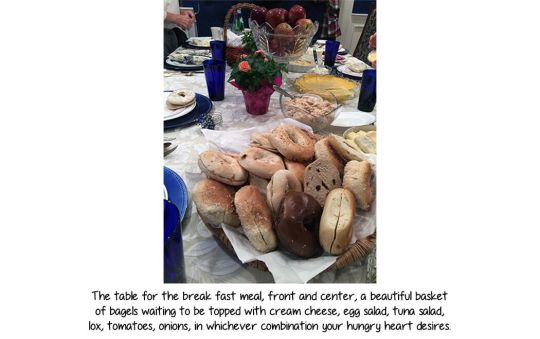
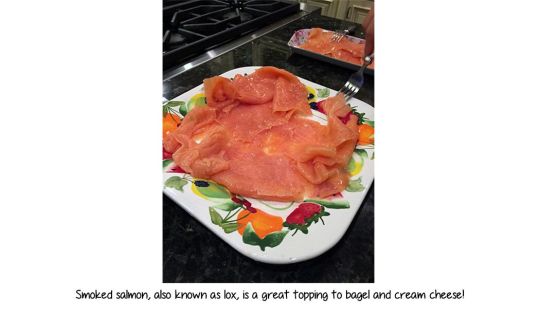

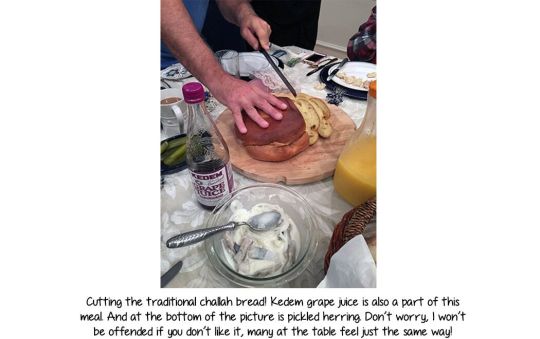

Okay guys, I have to admit, the last one is not my photo. Give me a break, I had just ended my 25-hour fast! But, this perfect looking bagel is from one of my favorite Instagrammers and bloggers, Amy of What Jew Wanna Eat. She makes delicious, traditional Jewish recipes that she gets from her bubbe, but she adds her own personal twist (pictured above is bourbon and beet cured lox, say what!?). She has tons of great recipes up on her site, too.
Definitely check her out if you are looking to bring a Jewish dish to a dinner party, whether you are attending a Seder or just want to cook something new and different for the family!
Well, that’s all for me. I truly hope you enjoyed soaring through my explanations of Judaism, the High Holidays, and my family’s traditions. I hope you can see that spending time with family no matter where is an important part of the Holidays, along with following age-old customs and traditions! Enjoying food alongside these things is also key! L’chaim (cheers) to that!
– Danya Snowsky, Project Manager
Sources
4.
http://bit.ly/1O3quM1 (lunar calendar)